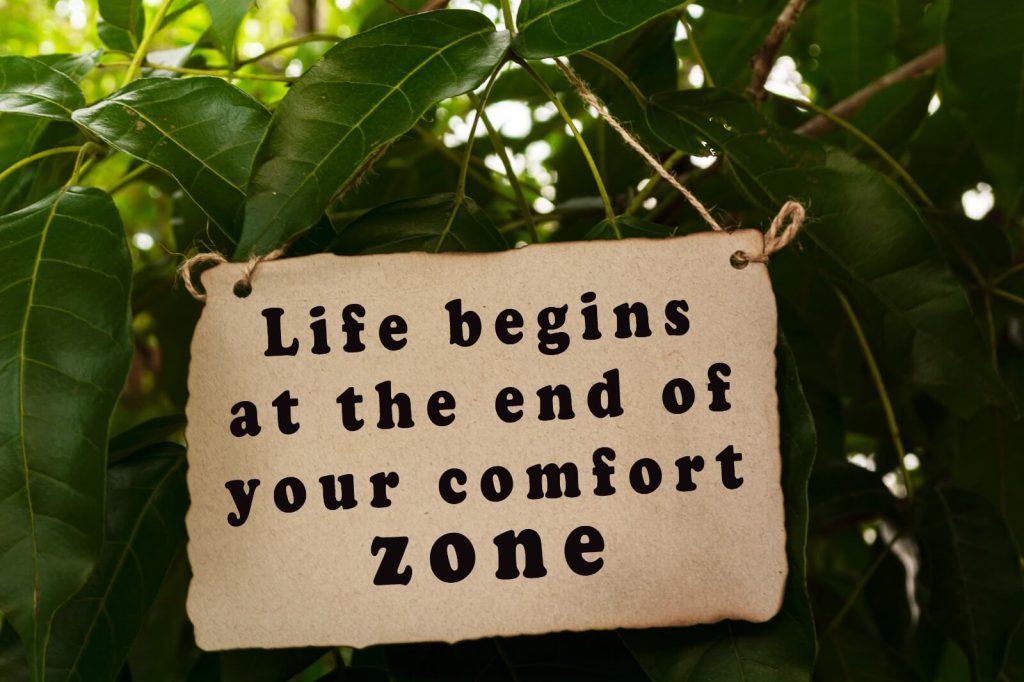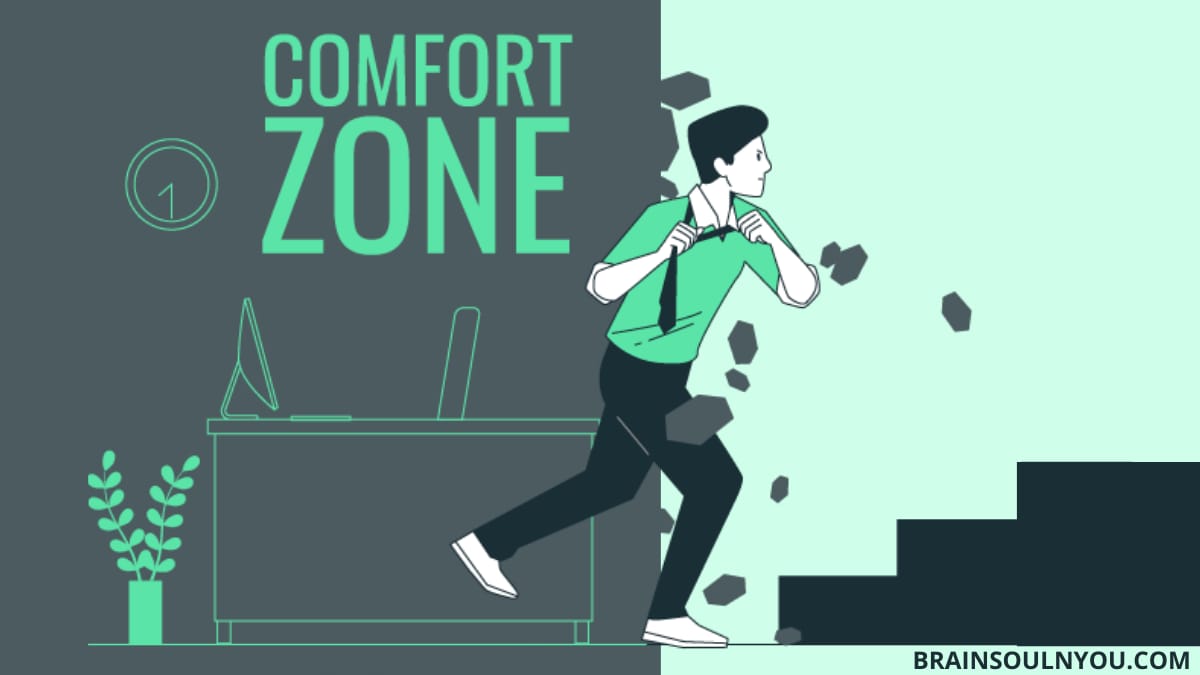The comfort zone refers to a psychological state where an individual feels familiar, safe, and at ease. It is a space or situation where one experiences low levels of stress or anxiety because it aligns with their existing knowledge, skills, and routines. The comfort zone can vary from person to person and may include areas such as work, relationships, activities, and daily routines.
Humans are the most powerful creature on this planet. Whatever technology we use today, is all a product of the human brain. His discovery proved that man can even go to the moon. But still, he is attracted to comfort.
Human is the creature of habit. Whatever work he does continuously creates neural pathways in the brain. These neural pathways become patterns in your thoughts and behaviors. That’s why it seems like you get stuck in a rut sometimes. If you feel like your life is on a loop, you may have to leave your comfort zone.
What is Comfort Zone?
The comfort zone is a psychological state in which a person operates in an anxiety-neutral state, using a limited set of behaviors to provide a stable level of performance, usually without a sense of risk. A person feels safe in his Comfort zone and feels like he has some control over the situation. All his immediate needs are met and he feels at peace.
In the comfort zone, individuals operate within their established boundaries and engage in activities that they are familiar with and feel competent in. It often includes routines, habits, and situations that have become predictable and require minimal effort or challenge. This familiarity and predictability create a sense of comfort, security, and control.

The comfort zone can manifest in various areas of life, such as work, relationships, hobbies, or daily routines. It is subjective and varies from person to person. What one individual finds comfortable, another person may find challenging or unfamiliar.
While comfort offers a sense of ease and stability, it can also limit personal growth and development. Staying exclusively within the comfort zone can lead to stagnation, missed opportunities, and resistance to change. Growth and learning typically occur when individuals step outside their comfort zones, embrace new experiences, take risks, and confront challenges.
Stepping outside the comfort zone can be uncomfortable and may involve facing uncertainty, fear, and potential failure. However, it is often through these experiences that individuals expand their capabilities, learn new skills, gain confidence, and discover their true potential.
Key Aspects of the Comfort Zone
Familiarity and Security: The comfort zone provides a sense of familiarity and security. It consists of activities, environments, and situations that individuals have become accustomed to over time. It offers a sense of predictability and control, reducing uncertainty and potential stress.
Reduced Anxiety and Stress: Within the comfort, individuals experience lower levels of anxiety and stress because they feel competent and confident in their abilities. They have a sense of mastery over the tasks or challenges they encounter, which contributes to their overall well-being.
Limited Growth and Development: While comfort provides a sense of ease, it can also hinder personal growth and development. Staying within the comfort zone often means avoiding risks, challenges, and new experiences that are necessary for learning and progress. Growth typically occurs when individuals step outside their comfort zone and embrace new opportunities and challenges.
Resistance to Change: The comfort zone is closely linked to resistance to change. When individuals are comfortable, they may be reluctant to step outside their established routines and habits. Change can disrupt the familiar and trigger feelings of discomfort or fear, leading to a preference for maintaining the status quo.

Potential for Stagnation: If individuals remain exclusively within their comfort zones for extended periods, there is a risk of stagnation. Growth, innovation, and personal development often occur outside the comfort zone. Stepping beyond familiar boundaries can lead to new perspectives, enhanced skills, and increased self-confidence.
Balance and Self-Care: While stepping outside the comfort zone is important for growth, it is also crucial to find a balance and practice self-care. Pushing oneself too far beyond the comfort zone without considering personal well-being and boundaries can lead to excessive stress and burnout. It is essential to assess and respect one’s comfort levels while also challenging oneself appropriately.
Expanding the Comfort Zone: It is not fixed and can be expanded over time. By gradually pushing the boundaries of what feels comfortable, individuals can broaden their experiences, skills, and confidence. Stepping outside the comfort zone in small steps and gradually increasing challenges can facilitate personal growth and adaptation.
While the comfort zone can provide a sense of security, it is important to recognize that growth and development often occur when individuals are willing to step outside of it. Embracing new experiences, taking calculated risks, and challenging oneself can lead to personal and professional growth, increased resilience, and a more fulfilling life.
How to Get Out of Your Comfort Zone?
To get out of your comfort zone, you need to learn how to control your natural fear and anxiety when you try new things. It starts with getting in touch with your emotions and changing your mindset.
Getting out of your comfort can be challenging but immensely rewarding for personal growth and development.
Certainly! Here are some tips to help you get out of your comfort zone:
1. Identify Your Comfort Zone
Reflect on the activities, situations, or routines that make up your comfort zone. Recognize the areas where you feel most at ease and where you tend to avoid taking risks or trying new things.
2. Set Clear Goals
Start by setting clear and achievable goals that push you beyond your comfort zone. Break them down into smaller, manageable steps. Having a specific target gives you something to work towards and helps you stay focused and motivated.
3. Start Small
Start by taking small steps. Begin with activities or situations that are slightly outside your normal comfort level but still manageable. Gradually increase the level of challenge as you become more comfortable and confident.
4. Embrace Failure and Learn from It
Understand that failure is a natural part of stepping outside your comfort. Embrace them as opportunities for learning and growth. Reflect on what you can learn from each experience and use that knowledge to improve and adjust your approach.
5. Seek Support
Surround yourself with a supportive network of friends, family, or mentors who can encourage and motivate you during your journey outside your comfort. Share your goals and challenges with them, and seek their guidance and support when needed. Having a support system can provide reassurance and accountability.
6. Practice self-compassion
Be kind and compassionate to yourself as you step outside your comfort zone. It’s normal to feel anxious or unsure in new situations but remind yourself that growth requires taking risks. Acknowledge your efforts and progress, celebrate your successes, and be patient with yourself as you journey into unfamiliar territory.

7. Embrace Discomfort
Understand that stepping out of your comfort zone will likely bring discomfort and uncertainty. Recognize that it’s normal to feel nervous or anxious, but don’t let those feelings hold you back.
8. Challenge Negative Thoughts
Identify and challenge any negative or self-limiting thoughts that may arise when you attempt to step outside your comfort zone. Replace them with positive affirmations and a mindset that embraces growth and learning.
9. Try New Experiences
Seek out new experiences that challenge you and expose you to different perspectives and environments. This could involve trying a new hobby, traveling to unfamiliar places, or engaging in activities outside your usual comfort zone.
10. Cultivate a Growth Mindset
Adopt a growth mindset that views challenges as opportunities for growth rather than obstacles. Embrace a mindset that believes in your ability to learn, adapt, and develop new skills.
11. Celebrate Your Progress
Celebrate even small achievements and milestones as you step outside your comfort zone. Recognize and appreciate the progress you make, as it will motivate you to continue pushing your boundaries.
12. Surround Yourself with Supportive People
Surround yourself with supportive individuals who encourage and inspire you to step outside your comfort zone. Seek mentors, coaches, or friends who have experience in the areas you want to explore. Their support and guidance can provide the necessary encouragement and motivation.
Remember, stepping outside your comfort zone is a process that takes time and practice. Each small step you take will help you build confidence and expand your comfort zone further. Embrace the opportunities for growth and discovery that lie beyond your comfort zone, and you may find yourself achieving personal milestones and experiencing a more fulfilling and enriching life.
Read also How to Change Your Mindset, How to Make My Daily Routine?
Love,
Saurabh Goel
Saurabh Goel
He is the Founder and CEO of the Training and Counselling Company ‘Brain Soul & You’. He is an NLP Wellness Coach, Life Coach, Brain analyst, and Trainer for Education, Corporate, and Entrepreneurship. For more than 7 years, he delivered presentations on entrepreneurship, mind programming, and motivation. He did his B.tech in IT and later choose to be a successful psychologist. He is helping people in various ways through his counseling and training sessions.


